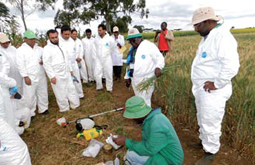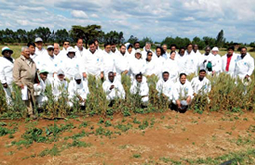CIMMYT Trains Early Career Scientists on Wheat Rust Diagnosis and Management
 The International Maize and Wheat Improvement Center (CIMMYT), in collaboration with Kenya Agricultural & Livestock Research Organization (KALRO) and Cornell University, recently trained 29 scientists from 13 countries on wheat rust disease diagnosis and management techniques, as well as innovative wheat breeding practices. The training, part of the Delivering Genetic Gains in Wheat (DGGW) project, took place at the KALRO research station in Njoro, Kenya, where CIMMYT’s wheat breeding and rust screening facility is located.
The International Maize and Wheat Improvement Center (CIMMYT), in collaboration with Kenya Agricultural & Livestock Research Organization (KALRO) and Cornell University, recently trained 29 scientists from 13 countries on wheat rust disease diagnosis and management techniques, as well as innovative wheat breeding practices. The training, part of the Delivering Genetic Gains in Wheat (DGGW) project, took place at the KALRO research station in Njoro, Kenya, where CIMMYT’s wheat breeding and rust screening facility is located.
More than 200 scientists have increased their capacity at these annual trainings since CIMMYT started organizing them ten years ago. The trainings focus particularly on studying resistance
to black (stem) rust, yellow (stripe) rust and brown (leaf) rust. Future wheat champions in national agricultural research systems (NARS) get new skills on innovative and cost-effective wheat breeding. These trainings are also a chance for CIMMYT’s Global Wheat Program to establish new partnerships and to collaborate on emerging challenges related to wheat breeding in different farming regions.
“The focus of this year’s event was to train the scientists on how to identify and record notes for stem rust occurrences and how to evaluate wheat material in the field, to better understand how wheat rust pathogens keep evolving,” said Mandeep Randhawa, wheat breeder and wheat rust pathologist at CIMMYT.
Despite its importance for global food security and nutrition, wheat remains susceptible to endemic and highly destructive rust diseases which can lead to 60-100 percent yield losses. Developing and distributing rust resistant wheat varieties is regarded as the most cost-effective and eco-friendly control measure, especially in developing countries, where the majority are resource-poor smallholder farmers with no access to fungicides to control the disease.
 As a global leader in wheat and maize breeding systems, CIMMYT has sustained efforts to develop high-yielding, disease-resistant and stress-tolerant varieties. In partnership with KALRO, CIMMYT identified and released over 15 commercial wheat varieties since the establishment of the stem rust screening facility in Njoro in 2008. Despite the appearance of new devastating strains of stem rust over the period, most of these released wheat varieties are highyielding with stem rust resistance, according to Randhawa. “Adequate management practices, including timely planting and application of right fungicides, have kept some of the high-yielding varieties such as Kenya Korongo and Eagle10 in production,” Randhawa explained.
As a global leader in wheat and maize breeding systems, CIMMYT has sustained efforts to develop high-yielding, disease-resistant and stress-tolerant varieties. In partnership with KALRO, CIMMYT identified and released over 15 commercial wheat varieties since the establishment of the stem rust screening facility in Njoro in 2008. Despite the appearance of new devastating strains of stem rust over the period, most of these released wheat varieties are highyielding with stem rust resistance, according to Randhawa. “Adequate management practices, including timely planting and application of right fungicides, have kept some of the high-yielding varieties such as Kenya Korongo and Eagle10 in production,” Randhawa explained.
More than 200 scientists have increased their capacity at these annual trainings since CIMMYT started organizing them ten years ago. The trainings focus particularly on studying resistance to black (stem) rust, yellow (stripe) rust and brown (leaf) rust”.
Several high-yielding rust resistant wheat lines are in pipeline for national evaluation to release as wheat varieties in Kenya, he said.
The development of a portable, real-time diagnostics tool for wheat yellow rust, namely the Mobile and Real-time Plant DisEase Diagnostics (MARPLE) was another breakthrough in identifying and combating wheat rust. This mobile plant health diagnosis tool helps identify rust strains in three days instead of months. This is a game changer for the wheat sector, as rust control measures could be deployed before new rust becomes a large-scale epidemic. Led by senior scientist David Hodson, MARPLE is the result of the collaboration between CIMMYT, the Ethiopian Institute of Agricultural Research (EIAR) and the John Innes Centre. There are plans to scale up this innovation in Ethiopia, where it is expected to provide five million wheat farmers a lifeline to control wheat yellow rust.
At the training, participants such as Zafar Ziyaev from Uzbekistan, were glad to gain deeper understanding on how to use modern tools for rust surveillance and the control measures. Others acknowledged the importance of sensitizing and supporting farmers to grow rust-resistant wheat varieties.
Emeritus Professor Robert McIntosh, one of the trainers from the Plant Breeding Institute at the University of Sydney, acknowledged the need for wheat scientists to remain vigilant on rust outbreaks globally and the evolving nature of the pathogens.
“As rust pathogens spread from country to country and region to region, such trainings allow national scientists to learn about the need for constant awareness, the basic principles of epidemiology and genetics that provide the basis of breeding for durable resistance, and what the Njoro rust testing platform can offer to the NARS,” McIntosh said.